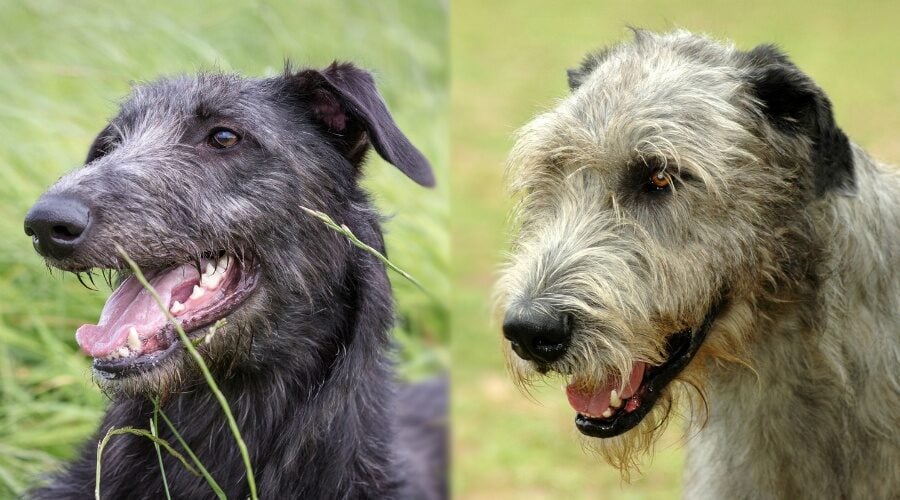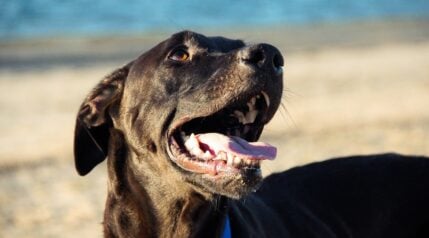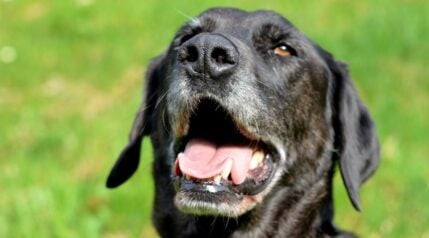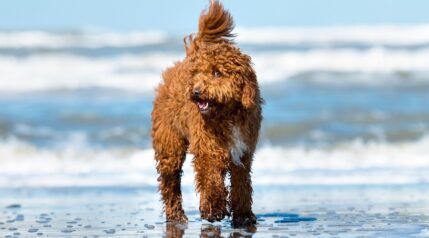The Scottish Deerhound and the Irish Wolfhound are extremely similar pups with only a few differences that set them apart, but it is these differences that might mean that one breed is more suited to your lifestyle over the other. For this reason, it is important that you fully commit to researching both breeds before you make a full and final decision.
They look almost identical, with the Irish Wolfhound being the largest pup, and they have the exact same wiry coat; it is extremely difficult to tell these guys apart! They also have the same gentle but courageous personality to match their noble exterior. Overall, the phrase ‘gentle when stroked, fierce when provoked’ is very apt for both the Scottish Deerhound and the Irish Wolfhound.
Read on to find out the finer details of each breed, and exactly how they differ from one another.
Breed Comparison
Scottish Deerhound
- Height 26-32 Inches
- Weight 75-110 Pounds
- Temperament Gentle, Dignified, Polite
- Energy Average
- Health Average
- Lidespan 8-11 Years
- Price $1,000 and Up
Irish Wolfhound
- Height 28-34 Inches
- Weight 90-140 Pounds
- Temperament Courageous, Dignified, Calm
- Energy Low
- Health Average
- Lifespan 6-9 Years
- Price $1,500 and Up
Breed History
They have separate histories, and they are from different countries, but their journeys are equally shrouded with myths and legends. Both breeds are shrouded in old tales, that range from just being fantastic dogs to being somewhat mythical creatures, and possibly even werewolves!
Scottish Deerhound

The Scottish Deerhound is also known as the Royal Dog of Scotland, which would suggest that this guy is a big deal! This guy is an old breed, who is believed to have been in Scotland long before the Scottish even arrived in the 9th Century. They are known as Deerhounds because they impressively hunted 400-pound wild Red Deer with large piercing antlers.
They were popular with royalty and noblemen, and it was this ownership restriction that brought them close to extinction on many occasions. It wasn’t until the late 19th Century that breed fanciers stepped in and saved the breed, and it was also around this time that the first Deerhound sailed to America. The first Deerhound was registered with the American Kennel Club (AKC) in 1886.
Still to this day, the Scottish Deerhound is a rare breed and is only really enjoyed by patriotic Scotts or sighthound lovers. In 2019, the AKC has ranked the Scottish Deerhound’s popularity as being in 158th place out of 193 dog breeds in America.
Irish Wolfhound

The Irish Wolfhound is believed to be a much older breed than the Scottish Deerhound and goes as far back as 391 A.D. when the Roman consul notably received a gift of seven Irish Wolfhounds. It was from then that their popularity rose.
He was originally used to hunt the now-extinct Irish Elk, who measured a tremendous six feet tall at the shoulders. It was in the 15th Century that wolves were overwhelming the Irish countryside, and their hunting focus shifted to them. They were known to take down a wolf with ease, and it was then that they were officially named the Irish Wolfhound.
They were so good at their job that they hunted the wolf, and many other large predators into extinction, and as such, they were no longer required. It was here that their own numbers diminished significantly.
Similar to the Scottish Deerhound, it was in the late 19th Century that fanciers took control of the situation and saved the breed, and recovered their numbers. The Irish Wolfhound is still a rare breed, but he is slightly more popular than the Deerhound, being in 76th place out of 193 dog breeds in the AKC popularity contest. He’s also commonly compared to other giant breeds as a family companion dog or guardian breed.
Appearance

This is where things get a little bit tricky! The Scottish Deerhound and the Irish Wolfhound are so similar in their appearance, that according to lovers of the breed, quite often even the professionals sometimes confuse the two breeds. They both resemble the Greyhound, but much larger in frame with longer wiry fur.
The Wolfhound is the tallest of the AKC breeds, even taller than the Great Dane who is often mistaken as the tallest of all dog breeds. From paw to shoulder, the males measure a minimum of 32 inches, whereas the Deerhound is limited to a height of 30 to 32 inches. The sky really is the limit with the Irish Wolfhound, however, kennel clubs in Ireland and England generally opt for him to be shorter by around one inch.
The Wolfhound is also much heavier in weight, weighing an almighty 120 pounds, compared to the much lighter Deerhound who weighs anywhere between 85 and 110 pounds, which is not light by any stretch! Their large size means that neither of these guys is suited to smaller accommodations, so bear this in mind if you are thinking about inviting one of them into your home.
Both breeds will fully mature and stop growing at around the age of three years old. Their bones and joints will strengthen at around the age of 10 months, so it is particularly important during this period that they are not over-exercised.
The Scottish Deerhound’s coat takes four recognized colors, whereas the Irish Wolfhound’s coat takes 13 recognized colors, including brindle. The grey color is the most recognizable and most popular color of them all.
The Irish Wolfhound is slightly longer than he is tall, which gives him his powerful stride, with a deeper chest than the Deerhound. The Deerhound has longer legs, and his ears are smaller and are set further back on his skull compared to the Wolfhound, whose ears are larger and covered in more fur. The Deerhound has more of a curved back compared to the Wolfhound.
Temperament

Not only are the Scottish Deerhound and the Irish Wolfhound similar in appearance, but they are also very similar in their temperament. Both the Scottish Deerhound and the Irish Wolfhound can only be described as the truest of Gentlemen; they are courageous but not aggressive, they are loyal but not overly clingy, and they are alert but dignified in their reactions.
They are close and affectionate with their family, and although neither of them is aloof with strangers, they are simply indifferent to them. They both make terrible guard dogs because they would let intruders stroll onto their estate and into their house without so much of a single bark to alert his master.
Despite their impressive size and muscular body, they are very fast and agile, making them such great hunters. Just as their name suggests, they are both members of the hound group, and they are both sighthounds in particular, which means that they hunt purely based on what they see. You should never let either of these guys off the leash in a public place because if they spot something, they will both be gone before you know it!
Due to their hunting background, it is advised that they only live in a doggy household, and not with cats or smaller furry animals such as rabbits. As long as they are both socialized from a young age, then they will both live well with other dogs. In fact, as they prefer to be in company, if you have to leave your pup for a few hours they would do better in the company of another dog.
Once you have exercised these guys, and they settle down at home, they are both the biggest canine snuggle bugs around, and neither of them would hesitate in laying on your sofa, and all over your lap. They are comfortable in the company of children, but it is advised that due to their massive size, neither of these breeds should be left alone with children to avoid any accidents.
Because of their social nature, they crave human interaction, and as such neither of these guys do well on their own and are known to suffer from separation anxiety.
Exercise

The Scottish Deerhound is the more energetic of the two pups, and he will require around 60 minutes of exercise a day, whereas the Irish Wolfhound will need less at around 40 minutes a day. They have long legs that need daily stretching, and their heart needs to pump a lot of blood around a lot of body. So no matter how much they will try to persuade you otherwise, he will need his daily exercise!
Being a lower energy dog, the Irish Wolfhound is more partial to an afternoon snooze or two (or even three!), whereas the Scottish Deerhound will snooze much less. For this reason, he needs more mental stimulation throughout the day to stop him from becoming bored and restless.
Having the ability to take down a 400-pound deer means that he could shred a sofa in minutes, so don’t be fooled by their calm and gentle ways. A bored hound is an unhappy hound, and that is not good for anyone!
Training

Both the Scottish Deerhound and the Irish Wolfhound are similarly independent creatures, who are more interested in searching for their next rabbit than listening and learning from their master. For this reason, if you are searching for a 100% obedient pup then it is unlikely that these guys are for you. If you are set on them being totally obedient, then you would do well to enroll them into professional obedience classes with a professional trainer.
Early socialization is important for these guys, and whilst their high prey drive will never be trained out of them, you can teach them to be comfortable and calm with other dogs of all shapes and sizes, and whilst you can try your best with cats, it is unlikely that they will ever be calm and collected around felines!
As it is recommended that neither of these guys should be let off the lead in a public area, it is important that they walk well on the lead as they are very strong pups. Therefore, it is important from an early age to leash train them to ensure that your daily walks are pleasantly calm and enjoyable for both you and your canine companion.
If you plan on crate training, make sure you are looking at crates meant for giant breeds. The AKC offers expert advice on how to leash-train your puppy.
Health

The Scottish Deerhound National Breed Club suggest that he is screened for the following health issues:
Factor VII D.N.A Test – A blood deficiency disorder whereby blood coagulation is limited, and as such excessive bleeding can occur.
Bile Acid Test – This will help to determine whether the liver is functioning as it should.
Cardiac Evaluation – This evaluation screens for a list of eye issues, such as Progressive Retinal Atrophy and Cataracts.
The Irish Wolfhound National Breed Club suggest that, in addition to the Cardiac evaluation described above, he should be tested for the following:
Elbow and Hip Dysplasia – This is an abnormal formation of the elbow and hip joints that can cause painful arthritis in later life.
Ophthalmologist Evaluation – This evaluation screens for a list of eye issues, such as Cataracts and Progressive Retinal Atrophy.
Overall, the Scottish Deerhound enjoys a healthy lifespan, considering his large size, of 8 to 11 years whereas the Irish Wolfhound enjoys a shorter lifespan of 6 to 8 years. While the lifespan of the Irish Wolfhound may seem short, it is an average lifespan of a dog his size. Overall, they are both generally healthy dogs, but the Scottish Deerhound is predisposed to the least amount of health issues when compared with the Irish Wolfhound.
Nutrition

A Scottish Deerhound will consume around 3 ½ cups of food a day, whereas the Irish Wolfhound will consume more at around 4 ½ cups of food a day. This is an important factor to consider if you are thinking about inviting one of these guys into your home. They eat a lot more than the average pooch, and as a result, monthly food bills are a lot more expensive.
Grooming

The Scottish Deerhound does not have a double coat whereas the Irish Wolfhound does. However, despite their coat difference, they are quite equal in their grooming demands. They are not heavy shedders, so they will only require brushing once or twice a week to keep their long wiry hair healthy and tangle-free.
While they do not ‘blow their coat’ in shedding season, you should still expect to find wiry hairs on your sofa and clothes. Both breeds are great when it comes to being a little lower maintenance in the grooming category, making them easier to groom overall.
Something else to consider is the fact that neither of these guys is hypoallergenic, and as such, neither of these breeds are suitable for families with any dog allergies.
Puppy Prices

The cost of a Scottish Deerhound puppy from a reputable breeder will start at around $1,000, whereas the cost of an Irish Wolfhound is slightly more costly and prices will begin from around $1,500. They are both rare pups, and the Scottish Deerhound will have, on average, 4 to 8 puppies in a litter whereas the Irish Wolfhound will only have 3 to 4 puppies, and these factors are reflected in the higher than average puppy price.
The Irish Wolfhound Club of America list dedicated rescue centers state by state if you wish to adopt an Irish Wolfhound. Whilst the Scottish Deerhound Club of America does not list rescue centers, it does list the contact details of nominated people who could point you in the right direction if you wish to adopt a Scottish Deerhound.
Final Thoughts
The Scottish Deerhound and the Irish Wolfhound are amazing creatures, who undoubtedly deserve to be much higher in the popularity contest. They are both relatively unknown and unexplored breeds, but breeds that are effortlessly cool and caring.
If you can prepare for their sight-based hunting traits and you can handle their immense size, then you are onto a rewarding and winning relationship. So, whichever Celtic canine you decide to welcome into your home, or employ as a predator hunter, rest assured that they are sweet and gentle souls, with a courageous heart that will love you and your family for as long as he is around.






The Great Dane is the tallest dog in the world.
It is true that many irishwolfhounds may be taller than the Great Danes, but only because the Great Dane standard has been changed in recent years. In fact, Great Danes are now much thinner, shorter and have smaller lips than the Great Danes of the 1980s.
They have ruined the breed standard. Great Danes are Molossians while the irishwolfhound is not.
Now many Great Danes look like hunting dogs.
The Great Dane that still retains the characteristics of its old standard is the most beautiful dog in the world. It is no coincidence that he is referred to as the ‘Apollo of dog breeds’. The Guinness Book of Records states that the Great Dane is currently the tallest dog in the world and this record still remains with the Great Dane and not the Irishwolfhound. According to the Guinness Book of Records, the irishwolfhound is the longest dog in the world, but not the tallest.
One should also remember that the standard of the irishwolfhound has changed throughout its history and that a breeder of this breed had to cross Great Danes with irishwolfhounds in order to safeguard the irishwolfhounds that were becoming extinct.
Lovely dogs
Team,
Thanks for the depth of the information contained in your article. MY wife and I have recently ‘got back into’ Wolfhounds in our retirement. I had a couple of these dogs many years ago but had significant problems with genetic problems from less than scrupulous breeders. What’s that saying?: ‘It’s line breeding if it works, it’s inbreeding if it doesn’t!’ For that reason we are trying to breed what seems to be a ‘typical’ Wolfhound, but there seems to be a lot of confusion around the place about which is Wolfhound and which is Deerhound. After reading your article, it seems that the new dog we just bought for breeding seems to be a Deerhound, not the Wolfhound we were told he was. However, I note that these were originally crossed with Great Danes and other breeds to re-establish the vanishing original Wolfhound breed, so all is well. The pups from our Wolfhound bitch and new Deerhound sire should be interesting, especially since we introduced a Mastiff/Wolfhound a generation ago as part of our foundation stock to inject some genetic variation, size, vigour, longevity, etc.
Thanks again for the informative and obviously well researched article. It was a most interesting read.
Regards,
Shane Flynn
Australia.
Got a Scottish Deer hound we love him to bits he’s crazy so very cheeky has to have the last word barks to get his own way so funny howls at the alarm we adore our Tracker runs with my mobility scooter to
We a deerhound saluki cross rescue bred for coursing. She was seized as a young dog and after a year with us has become an amazing part of family a truly loving gentle girl with huge intelligent personality. So many of these dogs in kennels dumped in uk
Dear Emma ~ thank you ever so much for your lovely photos and erudite & graceful text. I have loved both a Scottish Deerhound (Cayla) and an Irish Wolfhound (Arthur). Both were my alter-ego soul-mates. They are supremely loving and loyal, and I couldn’t choose between them except for one thing: Wolfhounds die too soon! Arthur loved a Cairn Terrier, and would hunker down on his elbows in order to play.
He once picked the Cairn up by his harness in order to remove him from a competing cluster of playmates! Cayla was my lovely lady, my soul-mate for sure. When she was slowing down, we bought Arthur as her consort, and she perked right up and lived an additional four years. They died within a few months of each other, even though Arthur was so much younger than Cayla. My heart was broken, and I had to sell that house because I couldn’t walk those trails without being sad. I’m currently looking for another Cayla, quite willing to do it all over again!
Thank you for the comments Christine, appreciate you sharing your experience with the breed. Good luck in your search for your next pup!
I’ve had four Irish Wolfhounds. First had a cat friend he used to walk with to the beach. My third Wolfhound had a cat and they were best of friends who used to sleep together and play together.
Thanks for stopping by to share, William! Appreciate you sharing your experience with the breed!